Scottish Employer Skills Survey 2020
Results from the Scottish Employer Skills Survey 2020.
The internal skills challenge
This chapter explores the incidence, density, causes and impact of skills gaps within the existing workforce (i.e. where employers consider their existing staff not to be fully proficient at their job). Skills gaps can be temporary, often the result of staff being new to the role, not being able to recruit suitably skilled applicants or intentionally taking on recruits who are not fully experienced to train them in the organisation's working practices. However, skills gaps can also be persistent, often the result of lack of investment in training, difficulties encountered developing skills in the workforce, or staff turnover. These persistent gaps can hinder an establishment's ability to function effectively and harm productivity.
This chapter also discusses employers' underutilisation of skills and qualifications in the workforce. It also considers upskilling requirements among employers, where employers anticipate that staff will need to acquire new skills over the next twelve months. The chapter considers the prevalence of such needs, the reasons for establishments needing to upskill, the occupations most affected by upskilling needs and the skills that establishments have noted need improving.
Incidence, volume and density of skills gaps
Overall, 12% of employers had any skills gaps within their workforce. This was lower than 2017 when 16% of employers had skills gaps.
There were few differences by region in terms of the incidence of skills gaps, as shown in Figure 8. The incidence of skills gaps increased with establishment size: from 4% among the smallest establishments with 2-4 employees to 40% among those with 100+ employees.
Establishments in the Public Administration (19%), Health and Social Work (17%) and Hotels and Restaurants (16%) sectors were more likely in 2020 to have skills gaps than those in other sectors. This was also the case in 2017 for Public Administration (23%) and Hotels and Restaurants (20%), although in 2017 Health and Social Work was in line with the overall figure (16%).
Across Scotland, 97,400 staff were considered not to be fully proficient at their job.
The number of staff with skills gaps varied across geography and sector, and typically reflected differences in the size of the regional and sectoral workforce. The number of staff described as lacking full proficiency ranged from 18,000 in Edinburgh and the Lothians Region to 1,800 in West Lothian Region, and by sector from 17,600 in the Health and Social Work sector to 1,100 in Information & Communications. By occupation, the largest volume of skills gaps was within those classed as Elementary Staff (17,500). Despite being the occupational grouping with the greatest number of employees, occupations classed as Managers had the smallest volume of skills gaps (5,700).
Figure 8 shows the incidence of skills gaps (i.e. the proportion of employers reporting any skills gaps) overall for Scotland and by ROA region, and the density of skills gaps (the proportion of the workforce considered to lack full proficiency).
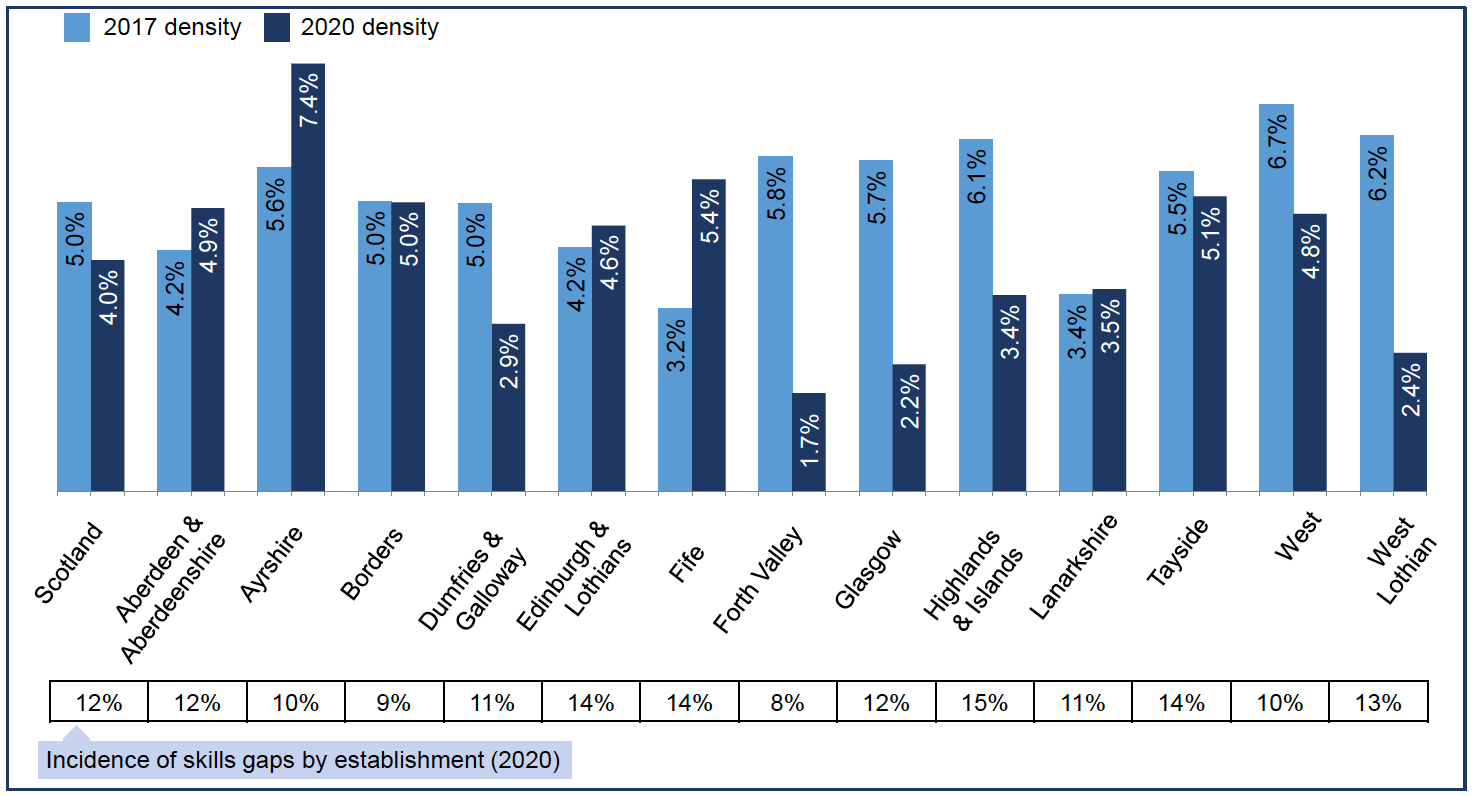
Base: All establishments (2020 Scotland: 3,497; regional base sizes range from 87 in West Lothian Region to 500 in Highlands and Islands Region. In 2017 Scotland: 6,017; regional base sizes range from 167 in West Lothian Region to 865 in Aberdeen and Aberdeenshire Region).
"Regions" refer to ROA regions – see "Definitions" section of this report for more detail.
In % of all employees in Scotland were considered to have skills gaps. This was lower than in 2017 (5.0%).
By region, the highest proportion of staff with skills gaps was in Ayrshire Region (7.4%), while the lowest was in Forth Valley Region (1.7%).
As with skills gap incidence among employers, the proportion of the workforce that had skills gaps increased with establishment size, from 1.7% of employees in establishments with 2-4 employees to 4.9% of employees in establishments with 100 or more employees.
By sector, skills gap density was lower than average in Public Administration (1.5%) and Information and Communications (1.7%) and was highest in Manufacturing (6.7%). This is similar to the pattern in 2017, when skills gap density was highest among Manufacturing establishments (7.2%) and lowest among Information and Communications establishments (2.3%), although in 2017 Public Administration had a skills gap density of 4.9%, close to the 2017 average (5.0%).
By occupation, skills gap density was highest among Caring, Leisure and Other Services Staff (6.2%) and lowest among Managers (1.5%). Managers was also the occupation with the lowest skills gap density in 2017 (2.6%), while Sales and Customer Services Staff was the highest in 2017 (7.0%). Caring, Leisure and Other Services Staff was the only occupation for which skills gap density had increased since 2017 (from 4.2% to 6.2%), while the largest falls were among Managers (falling from 2.6% to 1.5%) and Machine Operatives (falling from 6.7% to 3.8%).
Further data on the incidence and density of skills gaps, and corresponding 2017 results, can be found in Tables 10 to 16 of the Background Tables.
Causes of skills gaps
The most common causes of skills gaps were staff members being new to the role (64% of all skills gaps) and that staff training was only partially completed (63%).
As in previous years, transient causes of skills gaps (staff being new to the role and training only being partially completed) were the most common causes of skills gaps, being a factor in three quarters of all skills gaps (75%), and the sole cause of around one in six of all skills gaps (17%). While transient factors contributed to around the same proportion of skills gaps as in 2017 (76%), they were the exclusive cause of a smaller proportion of skills gaps than in 2017 (23%).
There are some workplace activities such as introducing new technology or working practices which cause skills gaps in the short-term, but usually also reflect positive developments such as an investment in growth. In 2020 however, these potentially "transformational" activities were also in part caused by difficulties adapting to workplace changes during COVID-19. "Transformational" factors (introducing new technology or working practices) contributed to 42% of skills gaps, an increase from 33% in 2017. Of these skills gaps caused in part by "transformational" factors, 58% were also in part caused by difficulties adapting to workplace changes during COVID-19.
Other common causes of skills gaps included staff not having received the appropriate training (37%) and employers being unable to recruit staff with the required skills (34%). The causes of skills gaps are presented in Figure 9.
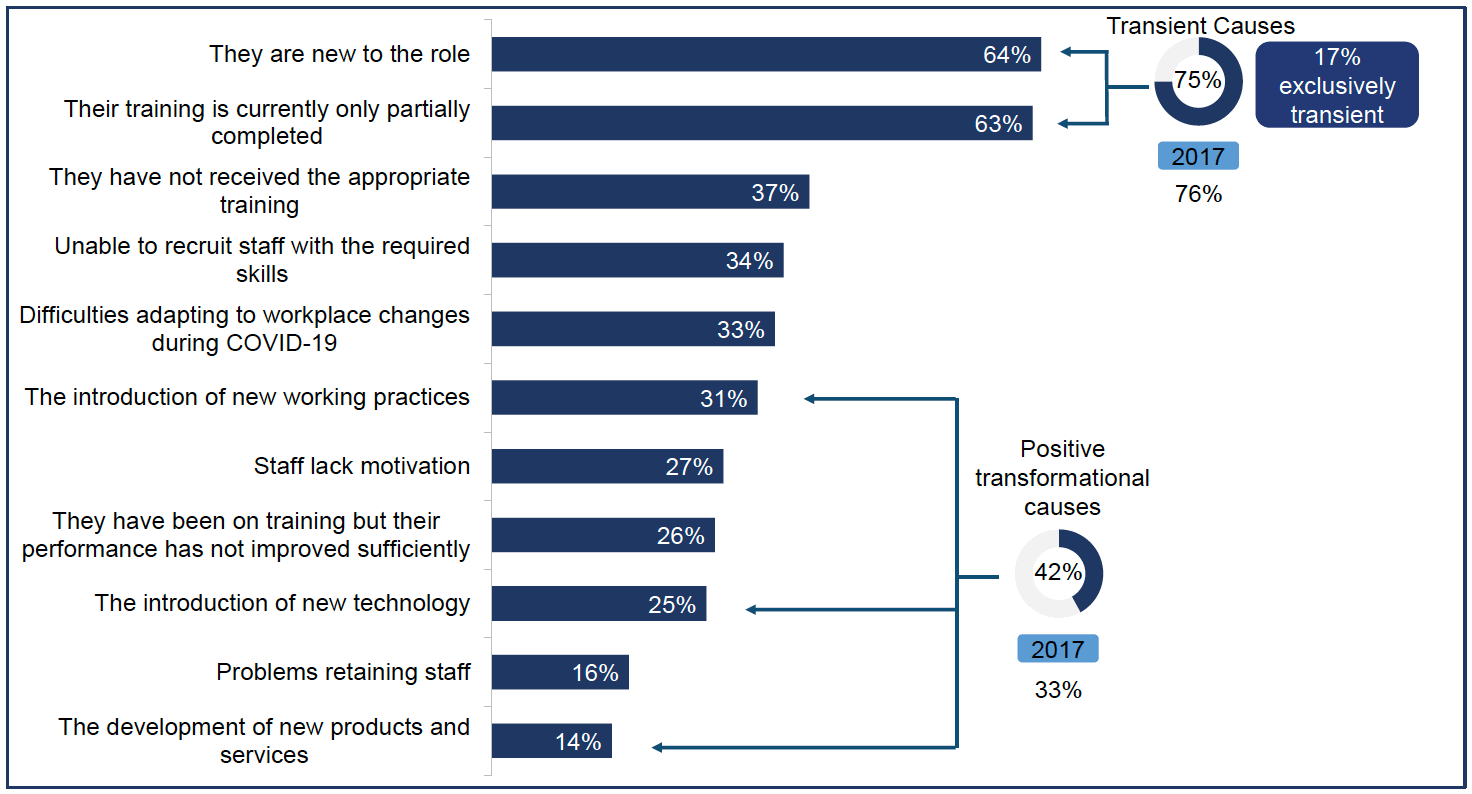
Base: All establishments with skills gaps (2020: 638; 2017: 1,502). Figures shown are based on skills gaps for up to 2 occupations randomly selected for each establishment – so, for example, "they are new to the role" was a cause of 64% of skills gaps followed up.
Further data on the causes of skills gaps, and corresponding 2017 results, can be found in Tables 17 and 18 of the Background Tables.
Skills lacking internally
The most commonly lacking technical or practical skills were specialist skills or knowledge needed to perform the role (lacking among 49% of staff with skills gaps) and the ability to solve complex problems requiring a solution specific to the situation (41%).
The largest increase since 2017 for individual skills lacking among staff with skills gaps was in the proportion of employees lacking basic IT skills (32% in 2020, up from 24% in 2017). The largest decreases since 2017 were regarding manual dexterity (from 18% in 2017 to 11% in 2020) and communicating in a foreign language (from 14% in 2017 to 7% in 2020).
Looking more broadly at the groups of skills lacking in the workforce, digital skills gaps, which includes both computer literacy / basic IT skills and advanced or specialist IT skills, rose between 2017 and 2020: in 2020, 47% of staff with a skills gaps lacked digital skills, compared with 36% in 2017. Similarly, basic skills, which includes both computer literacy / basic IT skills and basic numerical skills and understanding, were also lacking among a higher proportion of staff with skills gaps in 2020 (40%) compared to 2017 (33%). The technical and practical skills that were lacking among staff with skills gaps are presented in Figure 10.[5]
By occupation, 85% of staff with skills gaps within Skilled Trade occupations lacked the specialist skills or knowledge needed to perform the role, and 64% of Caring, Leisure and Other Service Occupations staff with skills gaps lacked knowledge of how their organisation works. Basic skills were lacking among 63% of Caring, Leisure and Other Service Occupations staff with skills gaps. Each of these findings was higher than the average across all skills gaps in other occupations.
Further data on the technical and practical skills lacking among staff with skills gaps, and corresponding 2017 results, can be found in Tables 20 to 22 of the Background Tables.
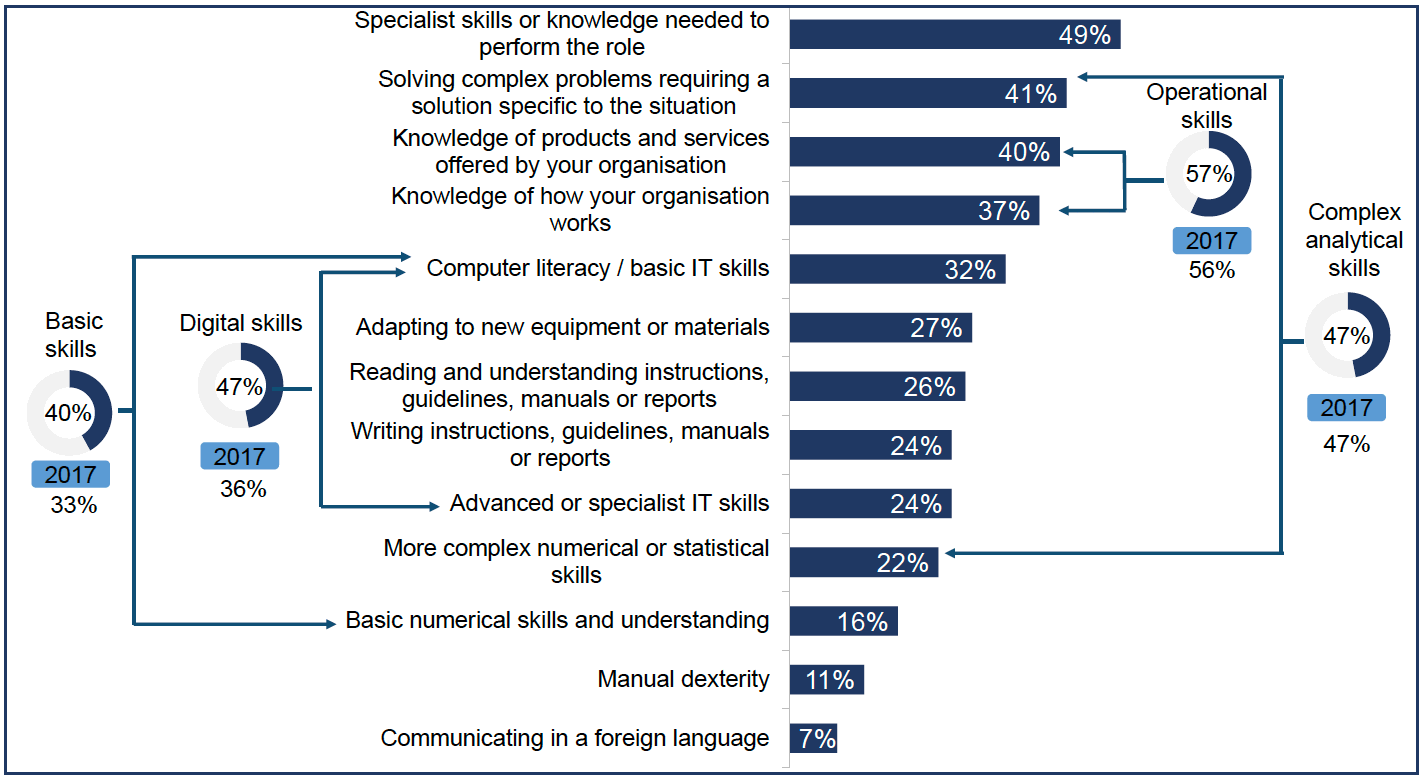
Base: All establishments with skills gaps (2020: 638; 2017: 1,502). Figures shown are based on skills gaps for up to 2 occupations randomly selected for each establishment – so, for example, "specialist skills or knowledge" was lacking in 49% of these skills gaps.
63% of staff with skills gaps lacked the ability to manage their own time and prioritise their own tasks and more than half lacked team working skills (56%).
A number of people and personal skills have become more common among staff lacking full proficiency since 2017, with the biggest increases being in sales skills (increasing from 24% in 2017 to 32% in 2020), customer handling skills (increasing from 45% in 2017 to 53% in 2020) and making speeches or presentations (increasing from 14% in 2017 to 20% in 2020). The largest decreases in terms of people and personal skills lacking among staff with skills gaps were for the ability to set objectives for others (decreasing from 25% in 2017 to 22% in 2020) and team working (decreasing from 59% in 2017 to 56% in 2020).
When grouping people and personal skills into broader areas of skills lacking, the only major change since 2017 was an increase in the proportion of staff with skills gaps that lacked sales and customer skills (58%, up from 48% in 2017). The people and personal skills that were lacking among staff with skills gaps are presented in Figure 11.
By occupation, some notable differences included 70% of Elementary Staff with skills gaps lacking the ability to manage their own time and prioritise their own tasks and 79% of Caring, Leisure and Other Service Occupations staff with skills gaps lacking team working skills, both figures much higher than average.
Further data on the people and personal skills lacking among staff with skills gaps, and corresponding 2017 results, can be found in Tables 23 to 25 of the Background Tables.
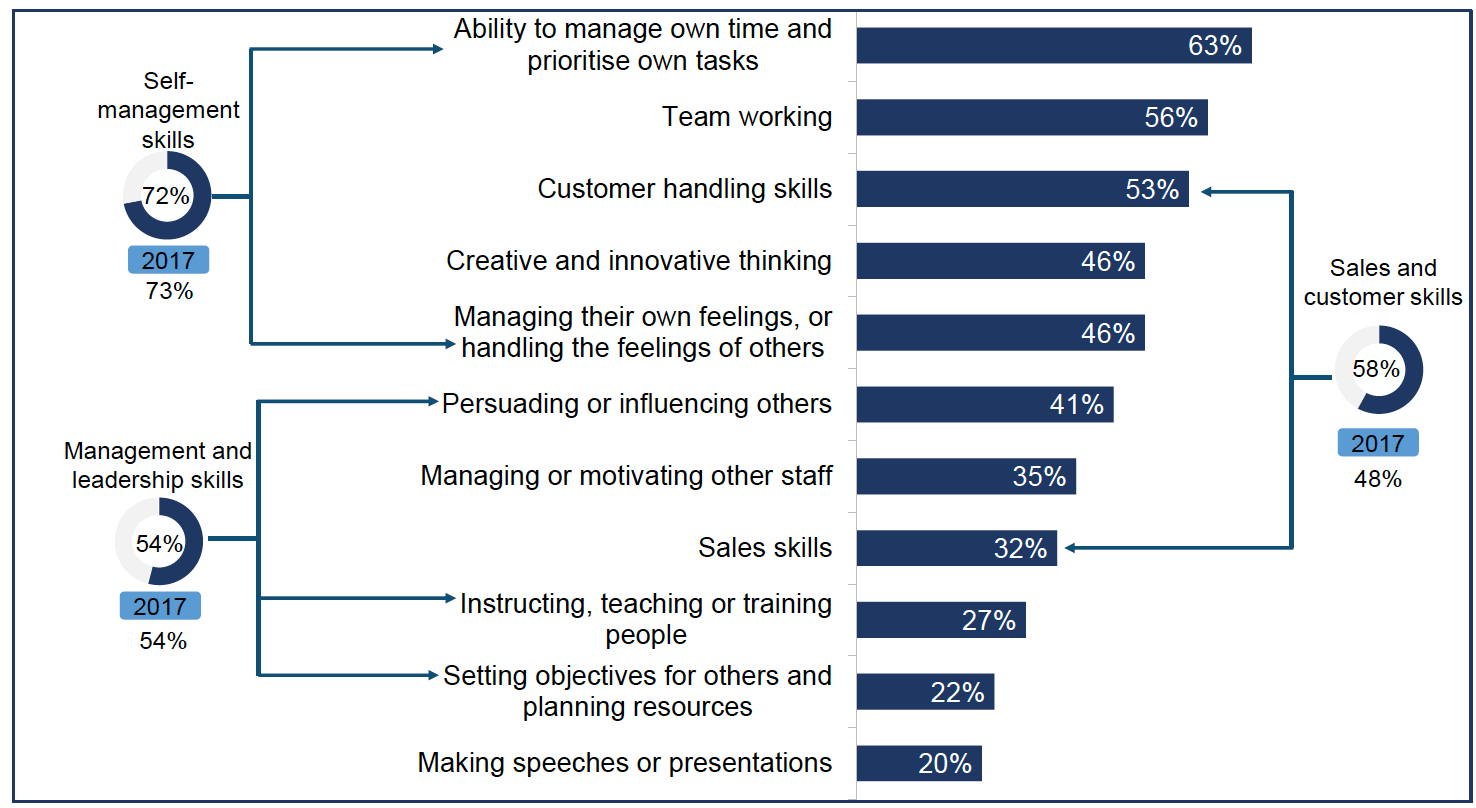
Base: All establishments with skills gaps (2020: 638; 2017: 1,502).Figures shown are based on skills gaps for up to 2 occupations randomly selected for each establishment – so, for example, the "ability to manage own time and prioritise tasks" was lacking in 63% of these skills gaps.
The impact of skills gaps
Two thirds of employers with skills gaps indicated these gaps impacted on how their site performed (67%). For just over half this included increasing workloads for other staff (53%), and for over a quarter (27%) they were causing increased operating costs. These figures were similar to findings in 2017.
Although the proportion of establishments with skills gaps that experienced an impact remained consistent with 2017, the extent of this impact had lessened, with the proportion saying it was having a major impact falling from 19% in 2017 to 12% in 2020.
Establishments that had skills gaps exclusively caused by transient issues were, perhaps unsurprisingly, much less likely to note any impact on their performance due to their skills gaps (42%) than those with any skills gaps caused by non-transient issues (73%).
As shown in Figure 12, the impacts of skills gaps in 2020 were similar to those found in 2017. That said, a smaller proportion of establishments with skills gaps indicated that they had caused difficulties introducing new working practices (24% down from 28% in 2017) or delays developing new products or services (14% down from 18% in 2017).
By sector, establishments in the Wholesale and Retail (79%) and Hotels and Restaurants (76%) sectors were more likely to report any impact on their performance due to skills gaps. In particular, establishments in these two sectors were more likely to report increased workloads for other staff to be an impact of skills gaps (Wholesale and Retail, 69% and Hotels and Restaurants, 68%). Hotels and Restaurant establishments were also the most likely to report difficulties in responding to or adapting to workplace changes as a result of COVID-19 because of their skill gaps (30%). Wholesale and Retail employers in contrast were among the establishments most likely to have lost business or orders to competitors due to skills gaps (27%).
Further data on the impact of skills gaps can be found in Tables 26 to 29 of the Background Tables.
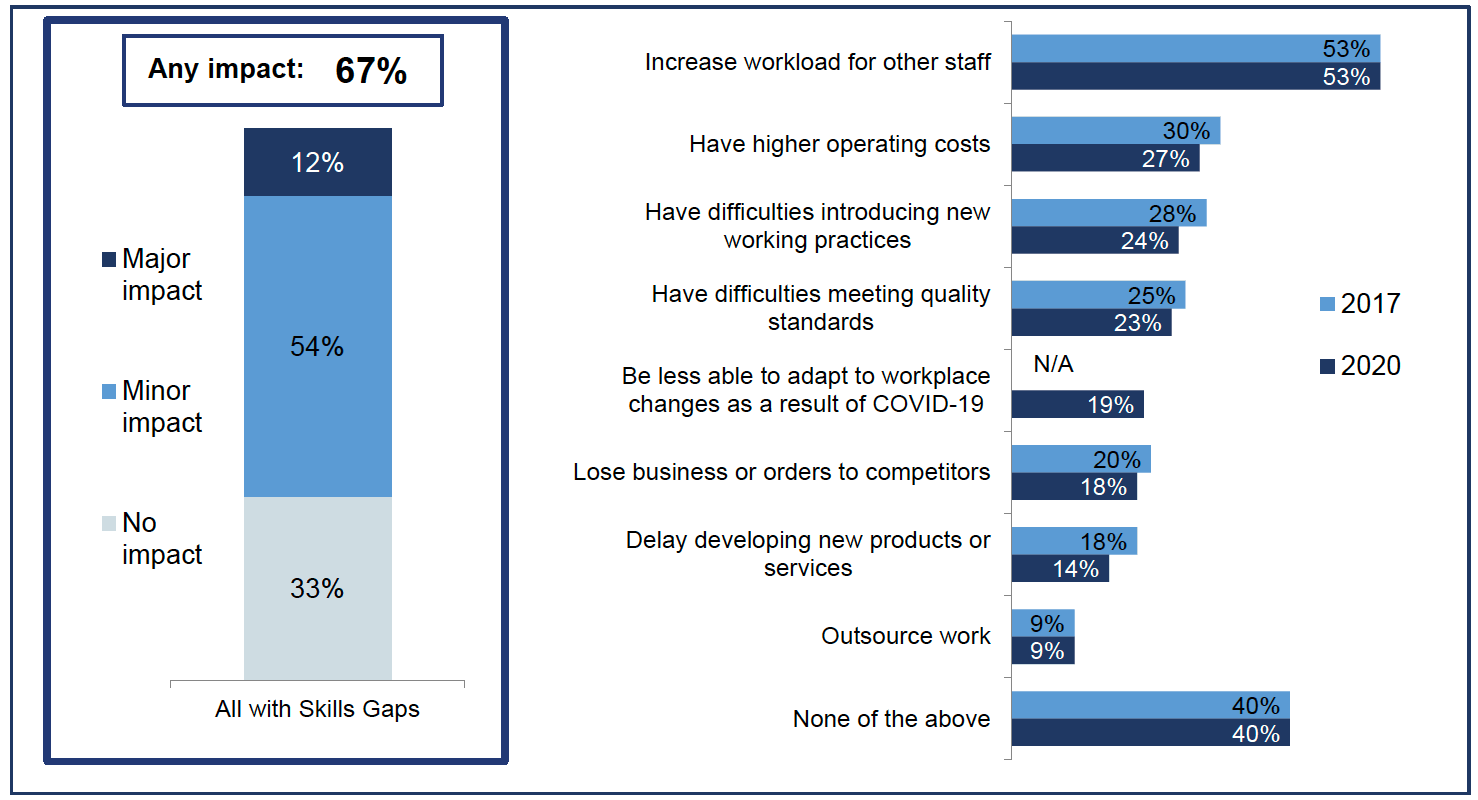
Base: All establishments with skills gaps (2020: 638; 2017: 1,502).
Under-use of skills and qualifications
Under-utilisation of skills and qualifications is defined as employees that have both qualifications and skills that are more advanced than are required for their current job role.
One third of establishments had staff that were under-utilised (33%). In total, 8% of employees were under-utilised in their role. Both figures represented a slight but significant decrease since 2017, when 35% of establishments had staff that were underutilised and 9% of the workforce had under-utilised skills and qualifications.
There were relatively few differences in terms of the likelihood of establishments having under-utilised staff by ROA region and size. However, nearly half of Hotels and Restaurants employers had any under-utilised staff (48%), twice the level among Primary Sector & Utilities employers (23%). This was similar in 2017 in terms of profile of sectors most and least likely to have under-utilised staff.
A greater proportion of the workforce were under-utilised in the Borders Region (13%) than among the workforce across the rest of Scotland, while a slightly lower proportion were under-utilised in the Edinburgh and Lothians Region, Fife and Highlands and Islands Regions (each 6%). The picture was slightly different in 2017. Although the proportion of the workforce under-utilised in the Fife Region (4%) was also low in 2017 and it was high in the Borders Region (11%), in 2017 the proportion in the Highlands and Islands Region (9%) was in line with the average while in Edinburgh and Lothians Region (10%) it was higher than the average across all other regions.
Among employees that worked at establishments with 2-4 employees, nearly one in five were under-utilised (19%), demonstrating a link between the proportion of the workforce that was under-utilised and the size of the establishment that they worked at (5 or more employees: 7%, 100 or more employees: 4%). This was similar to the profile in 2017.
By sector, the highest proportion of the workforce that were under-utilised was within the Financial Services (16%) and Hotels and Restaurants (14%) sectors. Just 3% of staff in the Public Administration sector were under-utilised. In 2017, the smallest proportion of under-utilised staff had been in the Manufacturing sector (4%), while the largest had been in the Information & Communications sector (24%).
Further data on the proportion of establishments reporting skills under-use and the proportion of the workforce that are under-utilised, as well as corresponding 2017 results, can be found in Tables 30 to 33 of the Background Tables.
Upskilling
Upskilling is defined as the anticipated need among employers that staff will need to acquire new skills over the next twelve months.
Overall, around three-quarters (74%) of employers had any upskilling needs among their workforce.
The proportion of employers needing to upskill any staff was higher in 2020 (74%) than in 2017 (69%). Excluding those employers whose upskilling needs were exclusively a result of needing to change workplace practices as result of COVID-19, 73% had upskilling needs, still a significant increase from 2017 levels.
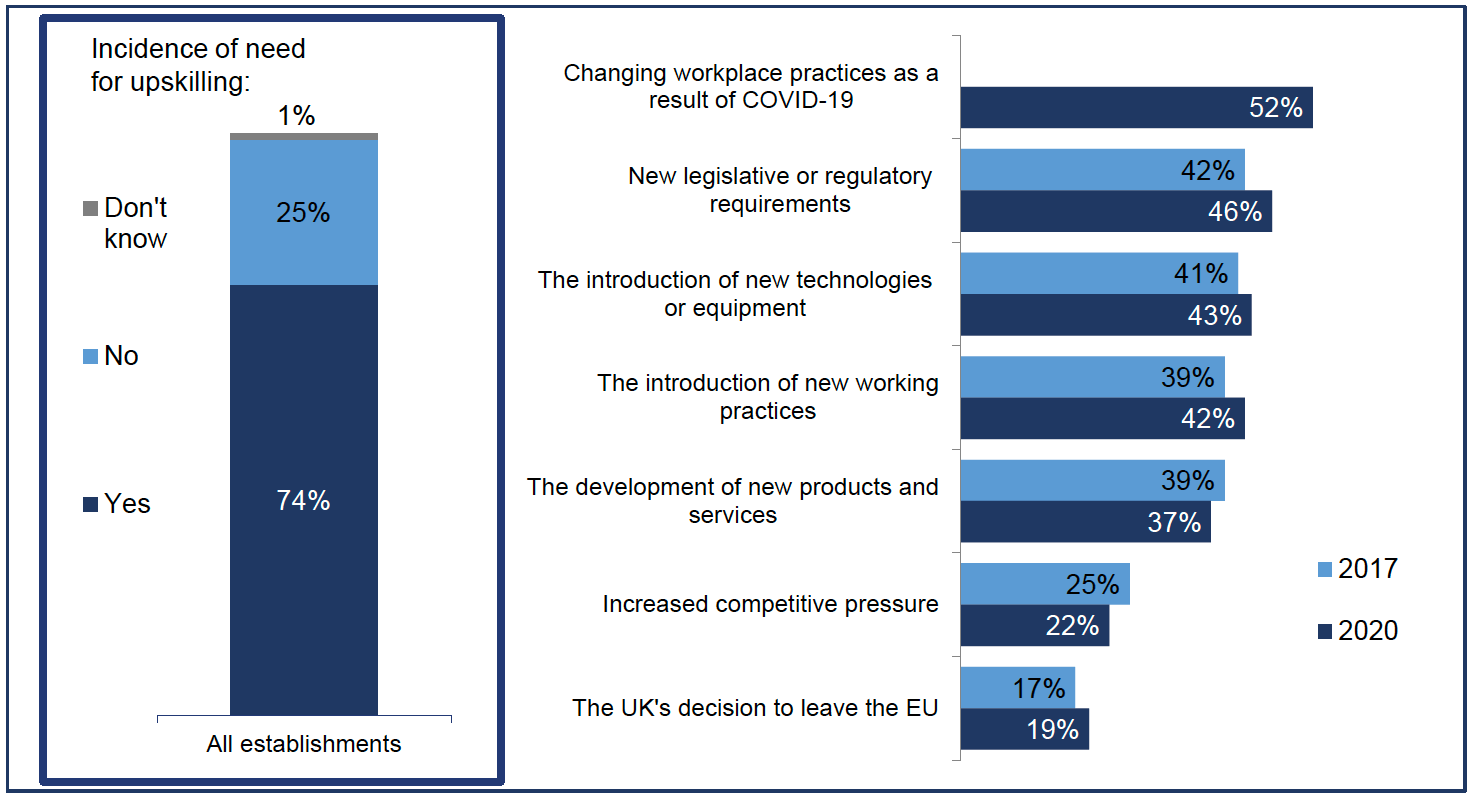
Base: All establishments (2020: 3,497; 2017: 3,064).
There was significant variation in upskilling needs by ROA region. Employers in and around Scotland's two largest cities were most likely to have need for upskilling (80% of employers in Glasgow Region and 78% of those in Edinburgh and Lothians Region), while employers in the Fife Region (68%) were the least likely to have upskilling needs.
Upskilling needs were more prevalent among large businesses than small businesses (89% of businesses with 100 or more employees compared to 68% of those with 2 to 4 employees). This difference by size was consistent with 2017.
Public Administration (87%) was the sector most likely to have need for upskilling, while Construction (58%) was the least likely. Hotels and Restaurants (79% vs. 60% in 2017) and Arts and Other Services (79% vs. 61% in 2017) were the sectors subject to the largest changes in upskilling needs.
Reasons for a need for upskilling
Reflecting the impact the pandemic has had on many businesses, changing workplace practices as a result of COVID-19 (52%) was the most common reason for a need for upskilling (see Figure 13). However, the proportion of businesses that needed to upskill for this reason varied significantly by sector. Those operating primarily in the public sector, such as Public Administration (70%), Education (67%) and Health and Social Work (65%), and the hospitality sector, such as Hotels and Restaurants (65%), were most likely to give this reason for having upskilling needs.
The next most common reasons for a need to upskill staff were new legislative or regulatory requirements (46%) and the introduction of new technologies or equipment (43%). Public Administration (65%) and Financial Services (60%) were the sectors most likely to have a need for upskilling as a result of new legislative or regulatory requirements. Information and Communications (70%) was most likely to have an upskilling need because of the introduction of new technologies or equipment.
Establishments were more likely to report a need for upskilling as a result of the UK's decision to leave the EU than they were in 2017 (19% compared to 17%). Employers in Edinburgh and Lothians Region (23%) were most likely to have upskilling needs as a result of Brexit, while those in the Ayrshire (14%) and West Regions (13%) were less likely to. Larger businesses (35% of those with 100 or more employees) were more likely than businesses overall (19%) to have a need for upskilling as a result of Brexit.
Occupations most affected by the need for upskilling
Managers (46%) were the occupation most affected by the need for upskilling, followed by Professionals (39%); Caring, Leisure and Other Services (38%); and Skilled Trades (35%) occupations. Figure 14 sets out the proportion of establishments that identified an upskilling need among their staff in that occupation.
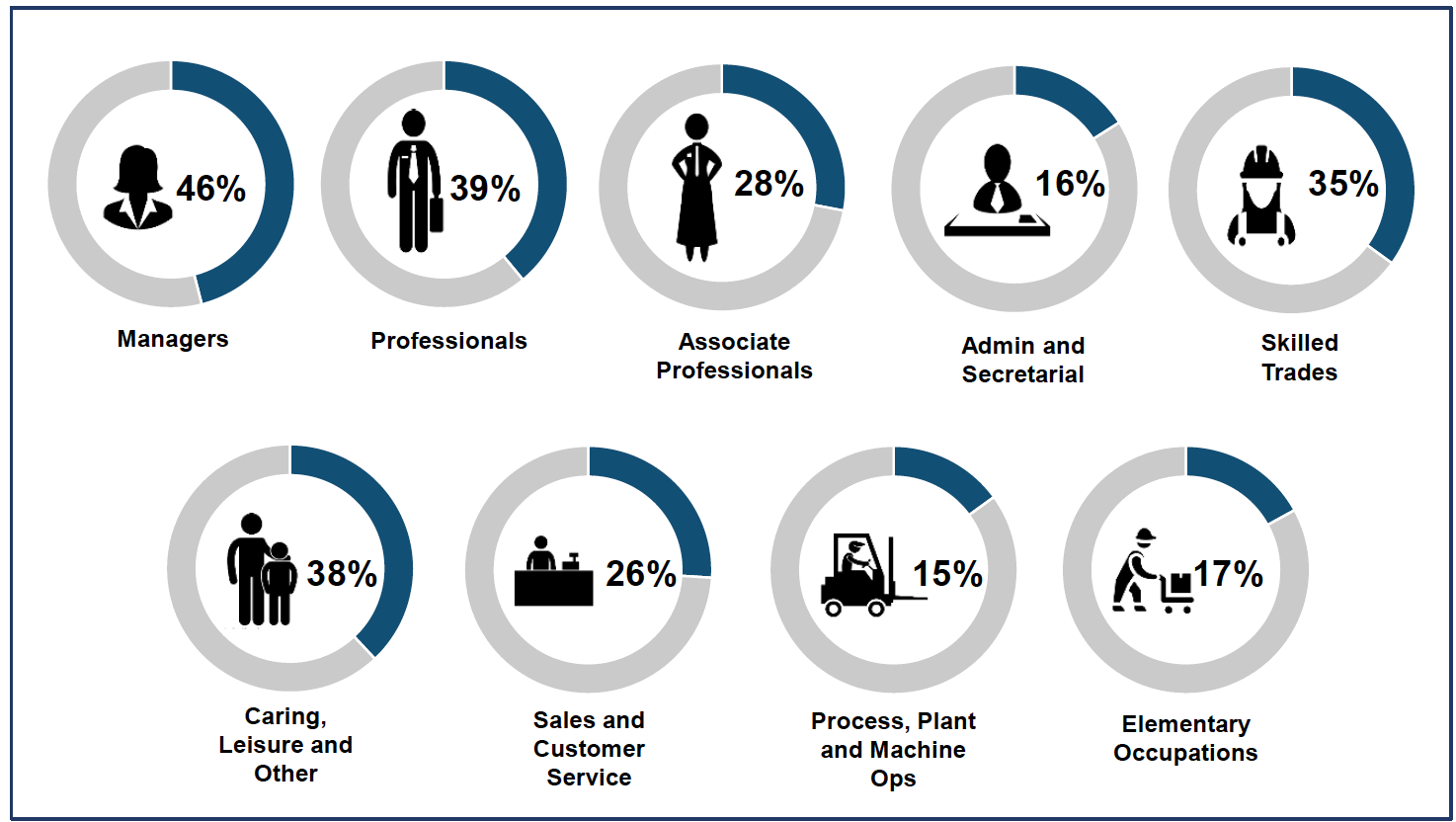
Base: All establishments that identified an occupation in need of upskilling and employ that particular occupation Managers (2,574); Professionals (635); Associate Professionals (436); Admin and Secretarial (1,709); Skilled Trades (919); Caring, Leisure and Other (504); Sales and Customer Service (752); Process Plant and Machine Operatives (553); Elementary Occupations (1,123).
Technical and practical skills that need developing
Adapting to new equipment or materials (49%), knowledge of products and services offered by the organisation (47%) and specialist skills or knowledge needed to perform the role (46%) were the technical and practical skills that establishments most commonly anticipated would need improving in the next year.
There was some significant variation across the different ROA regions in the technical and practical skills employers felt would need developing in the next 12 months. For example, employers in the Edinburgh and Lothians Region were less likely to report a need to upskill computer literacy / basic IT skills (27% compared to 36% overall) while those in Dumfries and Galloway Region (48%) were far more likely to anticipate this need.
The technical skills employers considered most likely to need upskilling over the next year also varied by employer size. It was, for example, much more common for establishments with 100 or more employees to mention a need to upskill their workforce in terms of specialist skills or knowledge needed to perform the role (65%) than establishments with 2 to 4 employees (36%).
When grouping types of technical and practical skills that require development in the next 12 months, operational skills (51%) and digital skills (51%) were those skills employers most commonly felt would need improving. Operational skills were the only grouped skill that had changed notably since 2017, decreasing from 57% to 51%. Complex analytical skills (43%) and basic skills (41%) were the grouped technical and practical skills employers least commonly reported needing improving.[6]
People and personal skills that need developing
The ability to manage their own time and prioritise tasks (42%), creative and innovative thinking (41%) and team working (41%) were the three people and personal skills employers most commonly anticipated a need for upskilling in the next 12 months.
There were some regional differences in the prevalence of anticipated people and personal skills needing upskilling in the next 12 months. In Glasgow Region managing or motivating other staff (45% compared to 38% overall) was the people skill which employers most commonly anticipated a need for upskilling over the next 12 months, while in Tayside Region, this was customer handling skills (46% compared to 37% overall).
For medium size businesses of 25-49 and 50-99 employees, managing or motivating other staff was the people skill employers most commonly felt would need upskilling in the next 12 months (61% for both size bands compared to 38% overall).
When grouping types of people and personal skills that need developing, just over half of establishments who anticipated a need for new skills in the next year reported this applying to self-management skills (53%) and management and leadership skills (51%). Employers less commonly anticipated upskilling needs around sales and customer skills (43%).
Further data on the reasons for upskilling and the types of skills employers feel need improving, with corresponding 2017 results, can be found in Tables 34 to 43 of the Background Tables.
Training and workforce development
This chapter looks at the training and development provided by employers to their staff. It covers levels of "off-the-job training" (defined as "training that takes place away from the individual's immediate work position, whether on your premises or elsewhere") and "on-the-job training" (defined as "activities that would be recognised as training by the staff, and not the sort of learning by experience which could take place all the time").
It also looks at the number of staff trained and the total time spent training ("training days") per employee, and the types of training provided.
Finally, the chapter explores barriers to training among establishments who would like to have provided more training over the last 12 months.
Incidence of Training and Workforce Development
Overall, 59% of employers had provided some form of training to staff in the 12 months preceding the survey.
Half (50%) of employers had provided on-the-job training to staff and a third (35%) had provided any off-the-job training.
The proportion providing any training in the previous 12 months in 2020 (59%) was lower than seen in 2017 (71%) and earlier iterations of ESS (73% in 2011, 70% in 2013 and 71% in 2015). The impact of the COVID-19 pandemic on training levels is explored later in this chapter.
The decrease was particularly marked for the proportion of employers providing off-the-job training in the previous 12 months (35%, down from 51% in 2017). The reduction in employers providing on-the-job training to staff was smaller (50% from 58% in 2017).
Figure 15 shows the change in training provision over time.
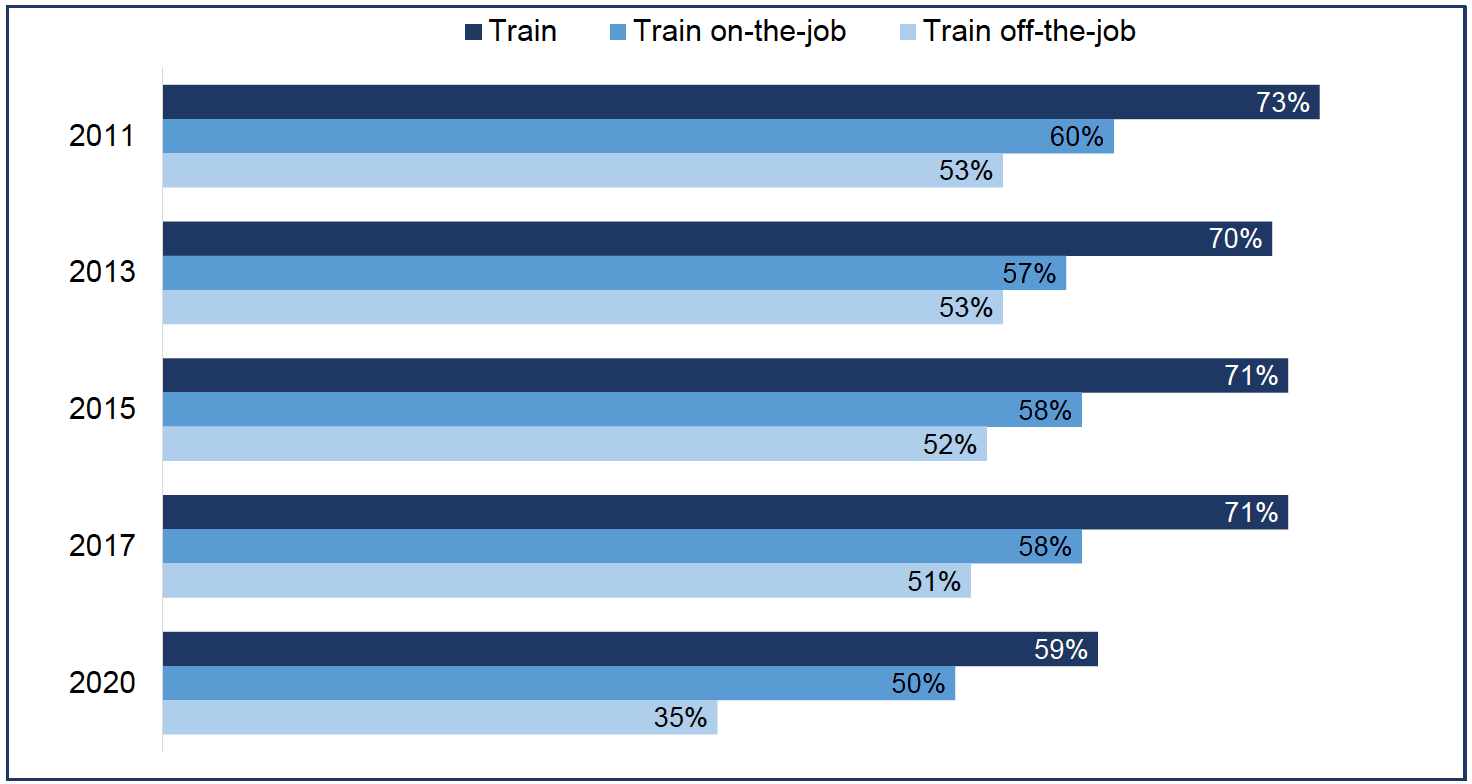
Base: All establishments (2011: 2,487; 2013: 6,014; 2015: 6,035; 2017: 6,017, 2020: 3,497).
The proportion of employers providing training for any of their staff in the last 12 months varied widely by establishment size, ranging from 45% among the very smallest (2-4 staff), up to 92% among those with 100 or more staff.
Training levels also varied considerably by sector (see Figure 16). Establishments in the Education sector were the most likely to have provided training for staff (88%), closely followed by Public Administration (83%) and Health and Social Work (79%). Establishments in Construction were the least likely to have provided training for staff (47%).
The decrease in training levels seen at the all-Scotland level was felt across almost every sector (the only exception being the Education sector, where the proportion training had not significantly changed when compared with 2017). Sectors particularly affected were Financial Services, where the proportion of establishments providing any training in the previous 12 months dropped from 85% to 61%, Manufacturing (down from 71% to 49%), Wholesale and Retail (down from 69% to 51%) and Transport and Storage (down from 70% to 53%).
Further data on the prevalence of training, with corresponding 2017 results, can be found in Tables 44 and 45 of the Background Tables.
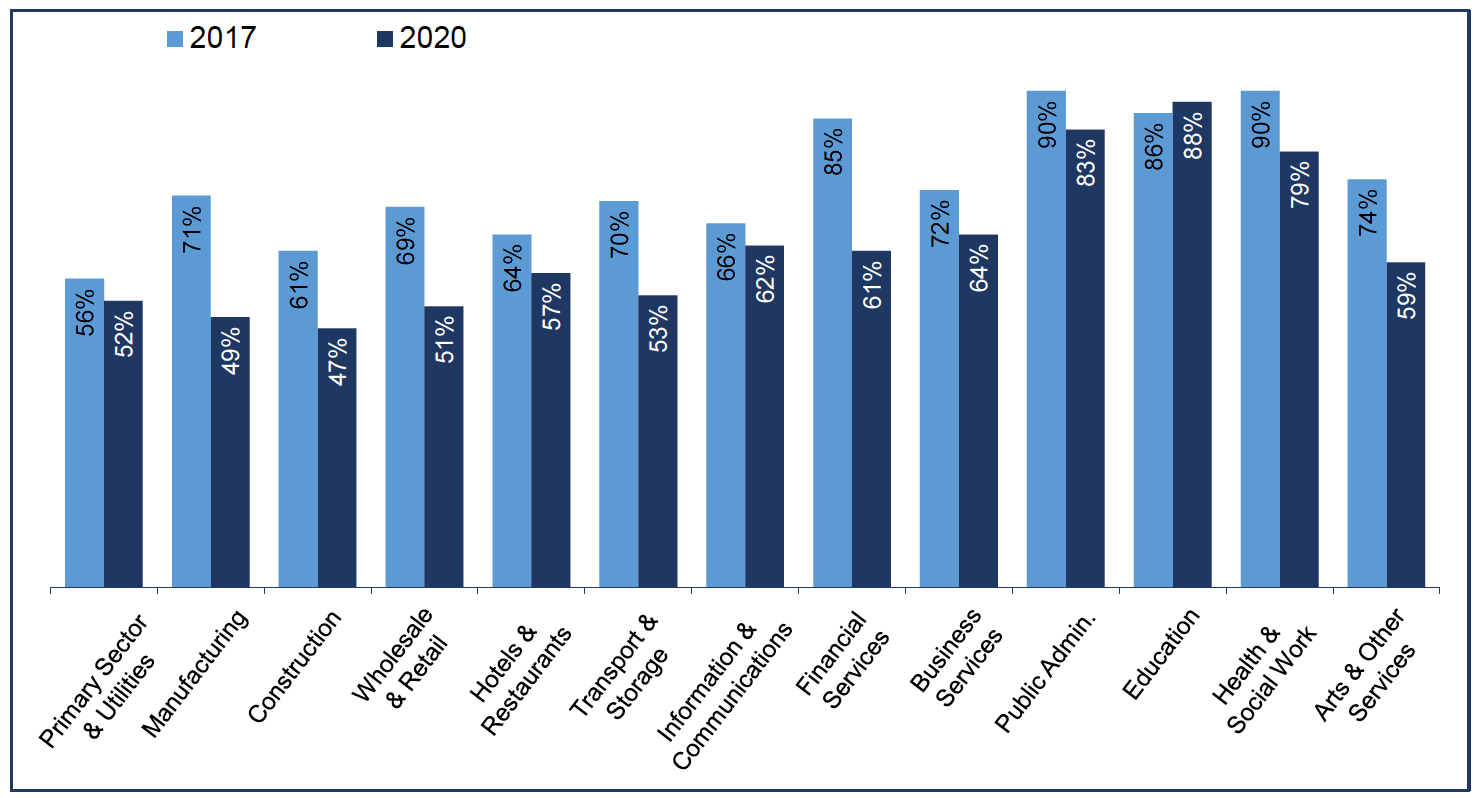
Base: All establishments (2020: 3,497; 2017: 6017; base by sector ranges from 54 in Financial Services 2020 to 933 in Wholesale and Retail 2017).
The proportion of staff trained
Across Scotland as a whole, employers trained 55% of their staff in the previous 12 months.
The proportion of staff trained over the previous 12 months in 2020 was lower than in 2017 (62%), having been reasonably stable since 2013 (2015: 62%; 2013: 65%). The reduction in the proportion of staff trained was evident across all size bands and sectors, in particular mid-size establishments with 25-49 staff (from 67% to 55%).[7]
As in previous years, larger employers trained a greater proportion of their staff (37% of staff working in establishments with 2-4 employees had received training, compared with 61% in those with 100 or more staff).
The largest decreases by sector were seen in the Arts and Other Services sector (46% vs. 63% in 2017), Wholesale and Retail (45% vs. 60% in 2017), Public Administration (45% vs. 60% in 2017) and Financial Services (60% vs. 74% in 2017). Employers in the Education sector continued to train the highest proportion of the workforce (74%), followed by Health and Social Work (66%).
By ROA region, the largest decreases compared to 2017 were seen in Highlands and Islands Region, where the proportion of staff trained over the last 12 months was down by around a third (47% vs. 73% in 2017) and West Lothian Region (50% vs. 21% in 2017). These regions were in the top three regions in Scotland in terms of proportion of the workforce receiving training in 2017; in 2020 both were in the bottom four.
Staff in Glasgow Region and in Edinburgh and the Lothians Region were the most likely to have received any training (61% and 60% respectively), and least likely in Borders (42%) and Dumfries and Galloway (43%) Regions.
Table 1 shows the 2020 figures by sector; further data on the proportion of staff trained, with corresponding 2017 results, can be found in Tables 47 and 48 of the Background Tables.
| Number trained | % of staff trained | |
|---|---|---|
| Scotland | 1.3m | 55 |
| Primary Sector & Utilities | 59,400 | 51 |
| Manufacturing | 82,100 | 47 |
| Construction | 66,600 | 52 |
| Wholesale & Retail | 155,300 | 45 |
| Hotels & Restaurants | 115,800 | 57 |
| Transport & Storage | 44,400 | 43 |
| Information & Communications | 21,000 | 31 |
| Financial Services | 47,900 | 60 |
| Business Services | 214,200 | 57 |
| Public Administration | 81,600 | 53 |
| Education | 147,100 | 74 |
| Health & Social Work | 253,900 | 66 |
| Arts & Other Services | 52,000 | 46 |
Base: All establishments.
Percentages are based on all employment rather than all establishments; figures therefore show the proportion of all staff within each subgroup trained over the last 12 months.
Type of training provided
Most of the training provided by employers was job specific training (86% of employers providing training). Health and Safety and/or First Aid training was also very common (71%).
Three-fifths of training employers (59%) had provided any form of induction training; this was slightly down from 2017 when the figure was 65%. This reflects the reduction in levels of recruitment, as seen in the "Recruitment and Skill-Shortage Vacancies" chapter of this report.
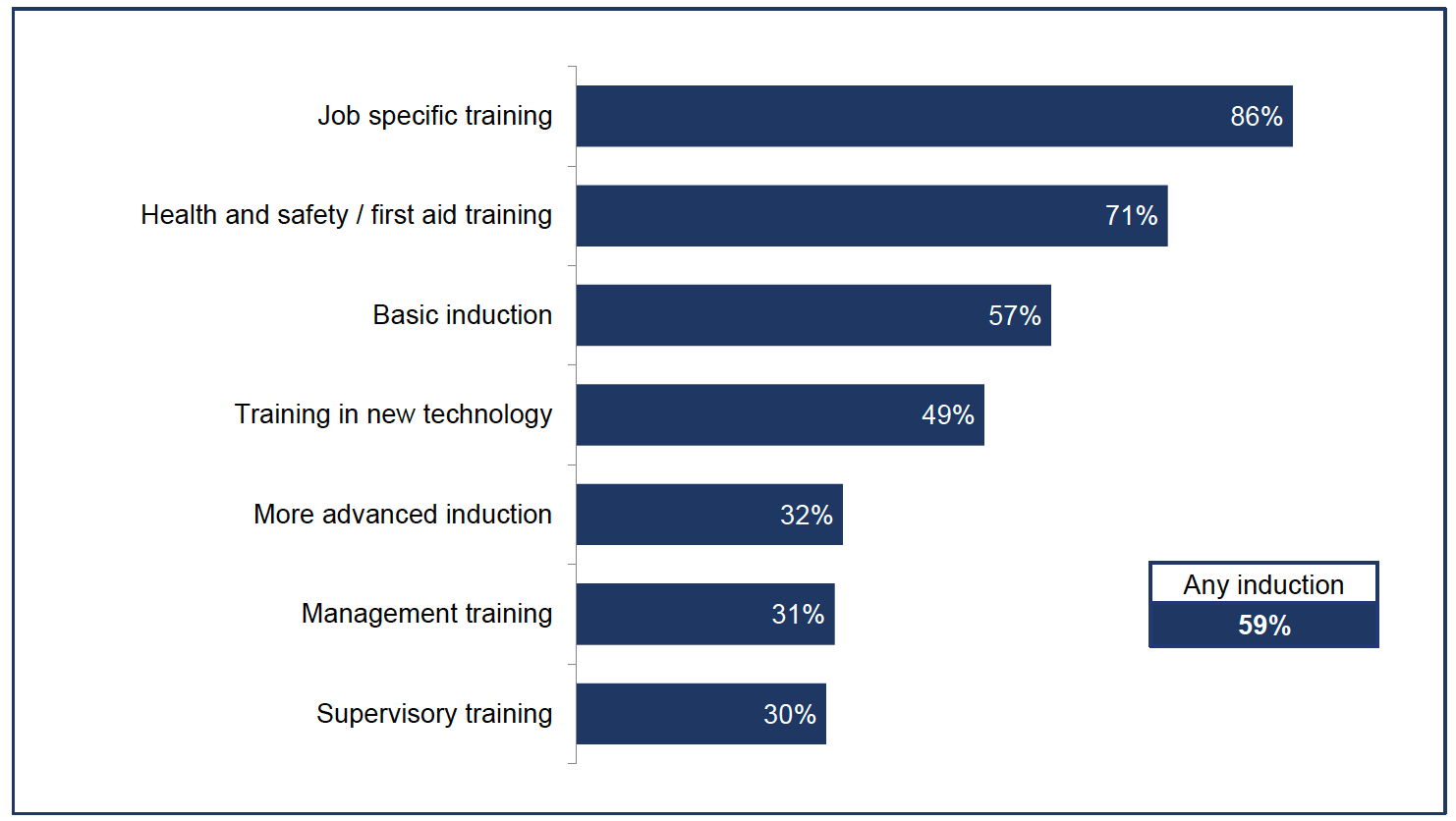
Base: All establishments that train (2,396).
The proportion of training employers offering online training or other e-learning where the employee completes the learning at a time of their own choosing had increased from 61% in 2017 to 73% in 2020.
Approaching half (46%) of training providing establishments had provided training to a nationally recognised qualification in the 12 months preceding the survey; this equated to 27% of all establishments (i.e. including non-training providing establishments). This was most commonly to SCQF Level 7 or above (15% of training providing establishments offered qualifications of this level).
Overall, 17% of staff receiving training had worked towards a nationally recognised qualification, equating to 9% of the workforce in Scotland as a whole. This was consistent with figures from 2017 (17% and 10% respectively).
Further data on the types of training arranged and funded by employers, with corresponding 2017 results, can be found in Tables 49 and 50 of the Background Tables.
Barriers and limits on training
The most common reason for not providing training was that employees were already all fully proficient and had no need for further training (58%).
A fifth (22%) of employers said that the COVID-19 pandemic had affected their training plans, most commonly because planned courses were suspended or otherwise not available. The full impact of the pandemic on training behaviour is covered in the next chapter. Figure 18 shows the most common reasons given for not providing training.
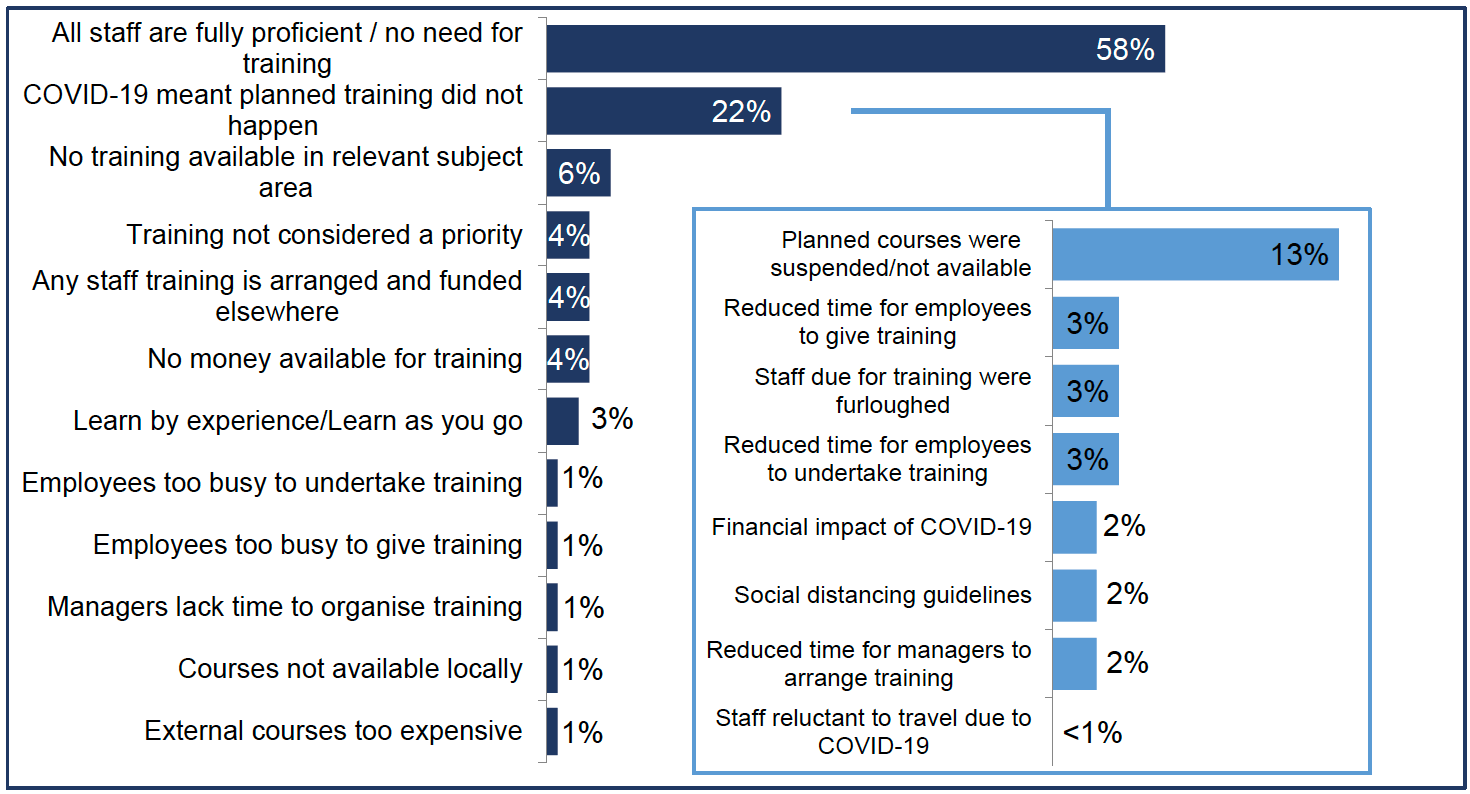
Base: Establishments that had not provided training to staff (1,068). Chart shows reasons mentioned by at least 1% of respondents.
Almost half (47%) of establishments that had provided training to staff said they would ideally have liked to have provided more training than they did. Two-thirds of these (65%) cited COVID-19 related reasons for not being able to do so. Other common responses included a lack of funds for more training (23%) and not being able to spare the staff time to undertake more training (22%).
If an employer had provided all the training they wished to (including those who provided no training out of choice) they are said to be in "training equilibrium" (see Appendix A – Definitions for more information). Overall, 55% of employers were in training equilibrium for the year preceding the survey, and 45% would like to have provided more training than they did (see Figure 19). These figures are unchanged from 2017.
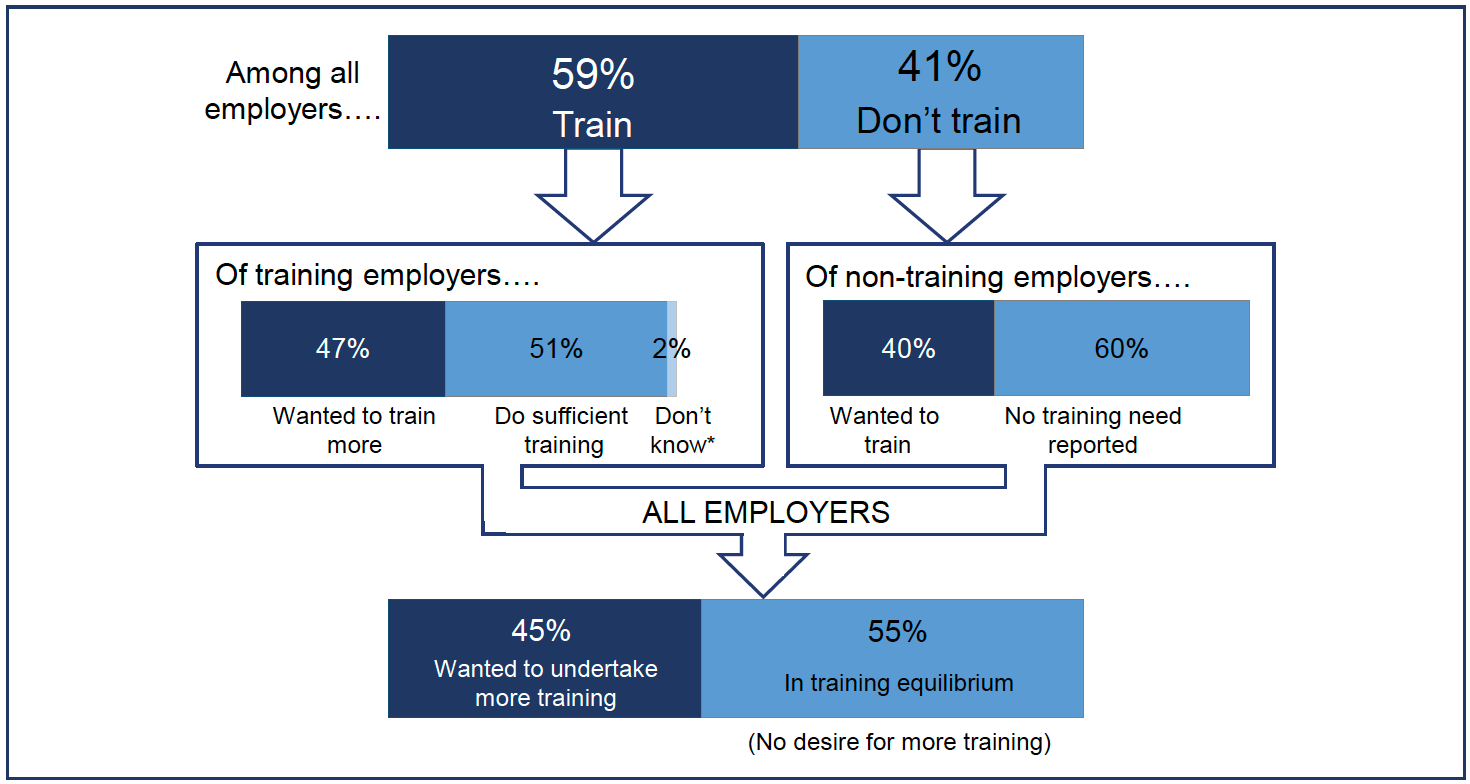
Base: All establishments (3,497); training employers (2,396); non-training employers (1,068).
*Training employers who responded "don't know" to whether they wanted to provide more training have been classed as being "not in training equilibrium".
Contact
Email: FHEstatistics@gov.scot
There is a problem
Thanks for your feedback